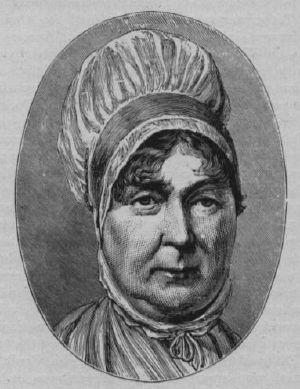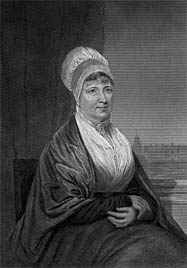Elizabeth Fry
Elizabeth Fry (née Gurney; May 21, 1780 – October 12, 1845) was an English prison reformer, social reformer and philanthropist. She was the driving force in legislation to make the treatment of prisoners more humane. She was supported in her efforts by a reigning monarch and has been depicted on the Bank of England £5 note.
Birth and family background
Elizabeth Gurney Fry was born on May 21, 1790 in Norwich, Norfolk, England to a Quaker family. Her family home as a child was Earlham Hall, Norwich, which is now part of the University of East Anglia. Her father, John Gurney, was a successful banker and businessman. In addition to being a partner in the famous Gurney Bank, he was the owner of a woolstapling and spinning factory. Her mother, Catherine, was a member of the Barclay family, who were among the founders of Barclays Bank. Catherine was a great source of influence to Elizabeth, who was very involved in charity work helping the poor of the district. Elizabeth loved to accompany her mother on these visits. Catherine believed that all children should have a well rounded education, and also insisted that Elizabeth and her siblings spend two hours a day in silent workship. Elizabeth's mother died when she was only twelve years old. As one of the oldest girls in the family, she was partly responsible for the care and training of the younger children, including her brother Joseph John Gurney.
Awakening of social concern
At eighteen years old, the young Elizabeth Gurney was deeply moved by the preaching of William Savery, an American Quaker. Motivated by his words, she took an interest in the poor, the sick, and the prisoners. She collected old clothes for the poor, visited those who were sick in her neighborhood, and started a Sunday school in her house to teach children to read. During this time, Elizabeth was appointed to the committee responsible for running the Society of Friends school at Ackworth.
Marriage and motherhood
In July 1799, Elizabeth was introduced to Joseph Fry, the son of a successful Quaker family from Essex. The two married on August 19, 1800 when Elizabeth was only twenty years old, and went to live in Joseph Fry's family home in Plashet (now East Ham in London). They had eleven children in all, including Katherine Fry, who wrote a History of the Parishes of East and West Ham (1888). Elizabeth remained commited to her religious beliefs and in March 1811 was recognized officially as a preacher within the Religious Society of Friends.
Fry's humanitarian work
In 1813 a friend of the Fry family, Stephen Grellet, visited Newgate Prison. What he saw there deeply shocked him and was informed that the conditions in the women’s section was worse. When Grellet told Elizabeth Fry about the way women were treated in Newgate, she decided she must visit the prison. The conditions she saw there horrified her. The women's section was overcrowded with 300 women and children amongst two wards and two cells. Although some of the women had been found guilty of crimes, others were still waiting to be tried. The female prisoners slept on the floor without nightclothes or bedding, and did their own cooking and washing in the small cells in which they slept.
Elizabeth began to visit the women of Newgate Prison on a regular basis. She supplied them with clothes and established a school and a chapel in the prison. She was unable to further her work for nearly 4 years because of difficulties within the Fry family, including financial difficulties in the Fry bank. Fry returned in 1816 and was eventually able to found a prison school for the children who were imprisoned with their parents. She began a system of supervision that was administered by matrons and monitors and required the women to sew and to read the Bible.
The great public work of her life dates effectively from the formation of the association for the improvement of the female prisoners in Newgate in April 1817. Its aims included the separation of the sexes, classification of criminals, female supervision for women and adequate provisions for religious and secular instruction. The accomplishments of this association led to the extension of similar methods in other prisons. She visited prisons in Scotlandand Northern England. Through a visit to Ireland, which she made in 1827, she directed her attention to other detention houses besides prisons. Her visits led to the improvement of the hospital systems and treatment of the insane.
Thomas Fowell Buxton, Fry's brother-in-law, was elected to Parliament for Weymouth and began to promote her work among his fellow MPs. In 1818 Fry gave evidence to a House of Commons committee on the conditions prevalent in British prisons, becoming the first woman to present evidence in Parliament.
Fry and her brother Joseph John Gurney took up the cause of abolishing capital punishment. At that time, people in England could be executed for over 200 crimes. Early appeals to the Home Secretary were all rejected, until Sir Robert Peel became the Home Secretary, they finally got a receptive audience. They persuaded Peel to introduce a series of prison reforms that included the Gaols Act 1823. Fry and Gurney went on a tour of the prisons in Great Britain. They published their findings of inhumane conditions in a book entitled Prisons in Scotland and the North of England.
Fry's other humanitarian work
Fry also helped the homeless, establishing a "nightly shelter" in London after seeing the body of a young boy in the winter of 1819/1820. In 1824, during a visit to Brighton, she instituted the Brighton District Visiting Society. The society arranged for volunteers to visit the homes of the poor and provide help and comfort to them. The plan was successful and was duplicated in other districts and towns across Britain.
After her husband went bankrupt in 1828, Fry's brother became her business manager and benefactor. Thanks to him her work went on and expanded.
In 1840 Fry opened a training school for nurses. Her programme inspired Florence Nightingale who took a team of Fry's nurses to assist wounded soldiers in the Crimean War.
Fry's legacy
Fry became well known in society. Some people criticized her for having such an influential role as a woman. Others alleged that she was neglecting her duties as a wife and mother in order to conduct her humanitarian work. One admirer was Queen Victoria, who granted her an audience a few times and contributed money to her cause.
Fry died at Ramsgate in 1845 and her remains were buried in the Friends's burial ground at Barking. It is reported that over one thousand people stood in silence as her body was buried.
In 2002 she was depicted on the Bank of England five pound note. Fry is also depicted on two panels of the Quaker tapestry—panels E5 and E6.
The Canadian Association of Elizabeth Fry Societies honors her memory by advocating for women who are in the criminal justice system. They also celebrate and promote a National Elizabeth Fry Week in Canada in the month of May.
ReferencesISBN links support NWE through referral fees
- Anderson, George M. "Elizabeth Fry: timeless reformer." America 173 (Fall 1995): 22-3.
- Clay, Walter Lowe. The Prison Chaplain. Montclair. New Jersey.: Patterson Smith, 1969.
- Fairhurst, James. "The Angel of Prisons." Ireland's Own 4539 (Fall 1996):5.
- Fry, Katherine. Memoir of the Life of Elizabeth Fry. Montclair, N.J.: Patterson Smith, 1974.
- Lewis, Georgina. Elizabeth Fry. London, England: Headley Brothers, 1909.
- Pitman, E.R. Elizabeth Fry. Boston, Mass.: Roberts Brothers, 1886.
- Rose, June. Prison Pioneer: The Story of Elizabeth Fry. Quaker Tapestry Booklets, 1994.
- Whitney, Janet. Elizabeth Fry: Quaker Heroine. New York, N.Y.: Benjamin Blom, Inc., 1972. Children's book
- Johnson, Spencer. The Value of Kindness: The Story of Elizabeth Fry. 2nd ed. 1976. (ISBN 0-916392-09-0)
External links
- Fry's Portrait
- A sermon by Elizabeth Fry
- A biography
- BBC - The five pound question: Who is Elizabeth Fry?
- Association of Elizabeth Fry Societies
- Council of Elizabeth Fry Societies of Ontario
Credits
New World Encyclopedia writers and editors rewrote and completed the Wikipedia article in accordance with New World Encyclopedia standards. This article abides by terms of the Creative Commons CC-by-sa 3.0 License (CC-by-sa), which may be used and disseminated with proper attribution. Credit is due under the terms of this license that can reference both the New World Encyclopedia contributors and the selfless volunteer contributors of the Wikimedia Foundation. To cite this article click here for a list of acceptable citing formats.The history of earlier contributions by wikipedians is accessible to researchers here:
The history of this article since it was imported to New World Encyclopedia:
Note: Some restrictions may apply to use of individual images which are separately licensed.

